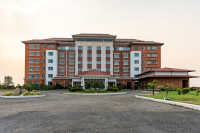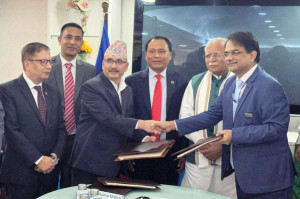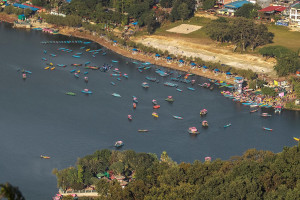Money
Transit and transportation protocol talks ‘positive’
The first day of bilateral talks between Nepal and China on the Nepal-China Transit and Transportation protocol ended on a positive note on Wednesday, with China expressing its willingness to allow landlocked Nepal to use all of its seaports for trading goods with third countries.
The first day of bilateral talks between Nepal and China on the Nepal-China Transit and Transportation protocol ended on a positive note on Wednesday, with China expressing its willingness to allow landlocked Nepal to use all of its seaports for trading goods with third countries.
In 2016, Beijing agreed to allow Nepal to use its ports to trade goods with third countries—a move that is expected to end Nepal’s sole dependence on India for overland trade.
However, to formally implement the agreement, both countries need to sign the protocol on Nepal-China Transit and Transportation.
The previous two meetings on the agenda were inconclusive. The two-day meet, which started in Kathmandu on Wednesday, is expected to finalise the issues by Thursday, the government officials said.
Wang Shuiping, director general at the Department of Transport Services, is leading a nine-member Chinese delegation, while the Nepali team is being led by Rabi Shankar Sainju, joint-secretary at the Ministry of Industry, Commerce and Supplies.
Navaraj Dhakal, joint-secretary at the ministry, said that during the meeting, Nepal requested China to allow access to all of its trading points including Chinese seaports located in Tianjin, Shenzhen and Xingang.
Nepal has been using two Indian ports for trade—the Kolkata/Haldia Port and the Visakhapatnam Port.
In 2015, after the five-month-long trade embargo launched by India over Nepal’s new Constitution’s provisions, Nepal was forced to opt for an alternative to Indian ports.
According to Dhakal, the three proposed seaports are close to Nepal. “The Chinese team is positive about Nepal’s request,” he said.
The nearest port in Tianjin is 3,000 km from the Nepal border. On the other hand, India’s Calcutta port is 1,000 km from Nepal.
The officials who attended Wednesday’s meeting said that the Chinese team responded positively but have expressed security concerns regarding the proposed trade and transit routes.
Dhakal said that Nepal’s agendas for the meeting were the transit operation modality, the import- and export-procedure and mode of transport and customs clearance.
Other topics such as the starting of interbank market connectivity between the two countries and building necessary infrastructure were also discussed in the meeting, he said. The meeting also focused on the development of necessary infrastructure under China’s Belt and Road Initiative.
In addition, the signing of a free trade agreement with China, increasing Chinese assistance in establishing special economic zones in Nepal, and the reopening the Tatopani trade route were also discussed at the bilateral meeting.
Last year Nepal joined the Belt and Road Initiative, which is China’s effort to develop a modern ‘Silk Road’ project connecting Asia with Europe, Middle East and Africa by road, railway, sea and air.




 21.12°C Kathmandu
21.12°C Kathmandu














